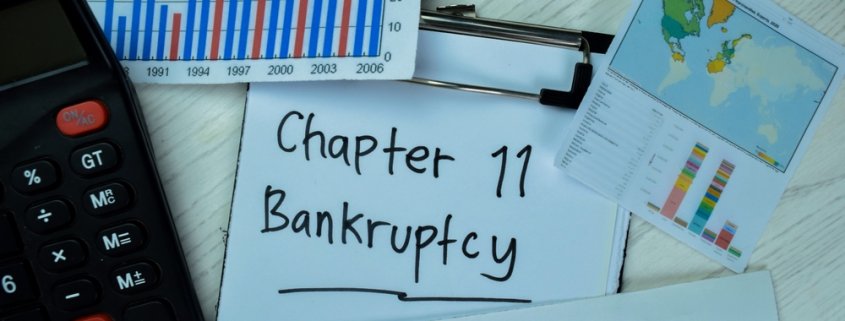Debtor In Possession: Meaning, How It Works, DIP Financing And FAQs
Last Updated September 8, 2023
Bankruptcy is a situation no business or individual wants to deal with — but unfortunately, it can happen. During the Chapter 11 bankruptcy process, it isn’t unusual for a business to have debtor in possession status over its property and other assets. But what does that mean?
By understanding the meaning of debtor in possession and how it can affect your operations and financing options, you can navigate this difficult period of restructuring your business and begin rebuilding your business credit score.
What Does Debtor in Possession (DIP) Mean?
A debtor in possession refers to an individual or business who has filed for Chapter 11 bankruptcy. During this period, the debtor holds property or assets that their creditors could use to satisfy their claims, but the debtor can continue using their business assets to generate cash flow (which can help repay the debts).
In other words, the debtor can control the property, even though their creditors have a lien against it. They still have the ability to run their business and continue its current operations, though they are now essentially operating as a trustee for their creditors.
What is Chapter 11 Bankruptcy?
Chapter 11 bankruptcy is a type of bankruptcy filing that allows a company to stay in business by reorganizing and restructuring itself in the best interests of its creditors. Businesses can make the best out of Chapter 11 bankruptcy by staying open and continuing to do business while restructuring their debts and assets. Notably, the business is not required to liquidate its assets as part of a Chapter 11 filing. By maintaining control of its properties, it can generate cash flow to help repay its creditors.
How Does Debtor in Possession Work?
As a debtor in possession, the business’s existing management is typically able to continue running their business like they normally would — though in cases of fraud or incompetence, the creditors may require that a trustee appointed by the court take control. While the business leaders are able to generally run the company like normal, they must get permission from the court to take certain actions (such as changing rental agreements, expanding or stopping key operations, or entering new vendor contracts). They must also close existing accounts and open new debtor in possession accounts.
As part of this process, the business that has filed for Chapter 11 bankruptcy is given the opportunity to propose a reorganization plan that will allow it to renegotiate its debts or repay its creditors. They have 120 days to submit their reorganization proposal and negotiate the plan with their creditors. The court will often discharge remaining debt if the company follows the agreed-upon plan for three to five years. The business is also able to obtain debtor in possession financing, which can provide sufficient working capital and cash flow so it can reorganize in a way that allows it to become profitable.
After the business successfully completes its restructuring in a manner that satisfies its creditors, it exits bankruptcy and is no longer considered a debtor in possession.
Example of Debtor in Possession
Filing for Chapter 11 bankruptcy doesn’t mean that your business is doomed. In fact, many well-known companies have filed for Chapter 11 bankruptcy and held debtor in possession status over their history. For example, General Motors, Chrysler, Ally Financial, Marvel Entertainment, and Six Flags have all filed for Chapter 11 bankruptcy.
When Marvel Entertainment faced heavy debts in the mid 1990s due to the collapse of the comic book industry, the company used its debtor in possession status to reorganize with a greater emphasis on entering the movie industry — a move that eventually led to billions in box office revenue.
How Debtor in Possession Affects a Business
While debtor in possession status usually means that the company’s current management can continue to run the business, it can still have a noteworthy impact on the company and its operations.
1. The Business Will Reorganize
A key part of filing for Chapter 11 bankruptcy is that the business must present a plan for how it will reorganize. This plan must be approved by the courts and the business’s creditors, along with presenting an actionable approach for how it will exit bankruptcy status. This could lead to wide-changing restructuring of the business.
2. The Business Must Follow Court Orders
As part of this process, many decisions that are made by the business must be approved by the court overseeing the Chapter 11 bankruptcy proceedings. This could include selling assets, expanding or halting certain business operations, changing rental agreements, and so on. Previously, the business could make these decisions on its own. But with debtor in possession status, such moves are subject to the court’s discretion.
3. A Trustee May Be Appointed
Though not common, there are several situations where a trustee may be appointed to run the business instead of the company’s current leadership. This could include cases of fraud or dishonesty, as well as situations where the debtor has demonstrated gross incompetence. If a debtor in possession doesn’t follow court orders or fulfill obligations like paying wages and taxes during the restructuring, the court can end DIP status and appoint a trustee.
4. Account Changes
Debtors in possession must close bank accounts that were in use before the Chapter 11 bankruptcy filing. New DIP accounts must be opened for use by the business, with actions related to these accounts subject to the court’s scrutiny. This includes applying for debtor in possession financing to ensure there is sufficient cash flow to maintain business operations.
What is Debtor in Possession (DIP) Financing?
Debtor in possession financing is a special type of financing that is only available to companies that have filed for Chapter 11 bankruptcy protection. As part of the process of restructuring a business and alleviating its current financial struggles, a business may take out a debtor in possession loan to improve its cash flow. Debtor in possession financing lenders often play a major role during Chapter 11 bankruptcy proceedings, taking priority over all other existing debt and creditor claims against the company — and the existing creditors are fine with this, as quite often, the financing is necessary for a troubled company to continue operating so it can pay off its debts. The DIP lender obtains a “senior position” on all existing liens due to the financing it has provided to the company.
Debtor in possession lenders will examine the company’s finances to determine if it is worthy of receiving a loan, and the court must approve the DIP financing. These loans are typically provided as fully funded term loans, which can result in high interest costs, but also provide the necessary infusion of cash to address existing cash flow issues and continue operations.
How to Get DIP Financing
Obtaining DIP financing should be done early on in the bankruptcy process. The company starts by gathering all information related to its current assets and debts to file the Chapter 11 bankruptcy petition.
After this, the company’s bankruptcy attorney will typically work to develop a Chapter 11 DIP financing plan and budget that will enable the company to exit bankruptcy. The plan must be feasible — as in, the company must be able to make its payments, and the DIP financing should provide sufficient cash flow to keep the business running and generate sufficient revenue to pay off its debts.
The court will determine whether to approve the DIP financing plan and budget, after which the business can obtain funding. The size and structure of the financing plan is also negotiated — it could be a term loan, revolving credit, or even involve invoice factoring.
Because of the extensive negotiations and court approvals needed to finalize DIP financing, this process can become rather lengthy. This is why it is recommended that companies apply for debtor in possession financing as early as possible when entering Chapter 11 bankruptcy.
Debtor in Possession FAQs
What is a debtor in possession bank account?
Businesses filing for Chapter 11 bankruptcy must close bank accounts that they used before filing for bankruptcy and open new accounts designated as “Debtor in Possession” (DIP) accounts with a U.S. Bankruptcy Code compliant bank. The bank must also have made an agreement with the bankruptcy trustee.
The new DIP bank account is where a company that has filed for Chapter 11 bankruptcy stores is funds while in the midst of the reorganization process. The new account is created to provide the business a source to operate while under bankruptcy protection, however, there are certain restrictions and oversight is required by the bankruptcy court for complete transparency.
What does debtor in possession mean on a check?
When a business has debtor in possession status during a Chapter 11 bankruptcy status, it must print “debtor in possession” on the paychecks it issues to its employees. The check is still valid. Businesses still have the responsibility to pay their employees, even after filing for bankruptcy protection.
Are there advantages of being a debtor in possession?
There is a saving grace to being a debtor in possession, that being you can continue to run your business, even as you work through the bankruptcy process.
Depending on your circumstances, you may also be able to obtain DIP financing to help keep your business running until you sell or restructure it. With financing assistance, you can get enough cash flow to complete a successful bankruptcy exit and avoid liquidating the company’s assets.
What is a small business bankruptcy case?
Small Business Cases are a simplified version of Chapter 11 bankruptcy that was first introduced in 2005. This bankruptcy filing is available for businesses with $3,024,725 or less of debt.
Michael McCareins is the Content Marketing Associate at altLINE, where he is dedicated to creating and managing optimal content for readers. Following a brief career in media relations, Michael has discovered a passion for content marketing through developing unique, informative content to help audiences better understand ideas and topics such as invoice factoring and A/R financing.



